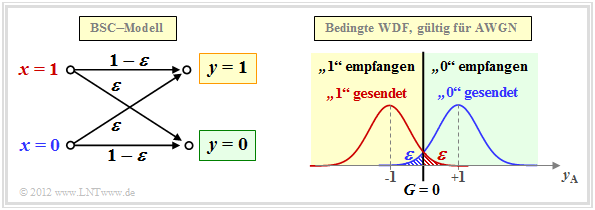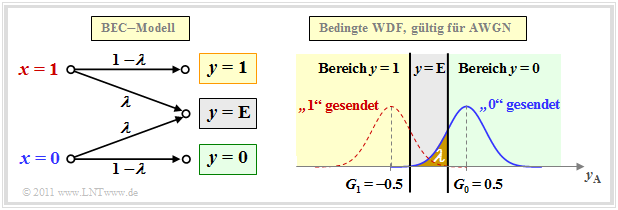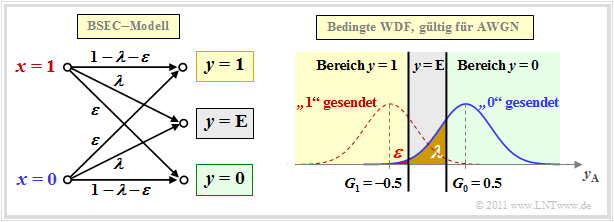Contents
- 1 AWGN channel at Binary Input
- 2 Binary Symmetric Channel – BSC
- 3 Binary Erasure Channel – BEC
- 4 Binary Symmetric Error & Erasure Channel – BSEC
- 5 Maximum-a-posteriori– and Maximum-Likelihood–criterion
- 6 Definitions of the different optimal receivers
- 7 Maximum likelihood decision at the BSC channel
- 8 Maximum likelihood decision at the AWGN channel
- 9 Aufgaben zum Kapitel
AWGN channel at Binary Input
We consider the well-known discrete-time AWGN Channel model according to the lower left graph:
- The binary and discrete-time message signal $x$ takes the values $0$ and $1$ with equal probability; that is, it is ${\rm Pr}(x = 0) = {\rm Pr}(\tilde{x} =+1) = 1/2$ and ${\rm Pr}(x = 1) = {\rm Pr}(\tilde{x} =-1) = 1/2$.
- Transmission is affected by additive white gaussian noise (AWGN) $n$ with the (normalised) noise power $\sigma^2 = N_0/E_{\rm B}$ . The dispersion of the Gaussian–WDF is $\sigma$.
- Because of the Gaussian WDF, the output signal $y = \tilde{x} +n$ can take on any real value in the range $-\infty$ to $+\infty$ . The signal value $y$ is therefore discrete in time like $x$ $($bzw. $\tilde{x})$ but in contrast to the latter it is continuous in value.
The graph on the right shows (in blue and red respectively) the conditional probability density functions:
- \[f_{y \hspace{0.03cm}| \hspace{0.03cm}x=0 } \hspace{0.05cm} (y \hspace{0.05cm}| \hspace{0.05cm}x=0 )\hspace{-0.1cm} = \hspace{-0.1cm} \frac {1}{\sqrt{2\pi} \cdot \sigma } \cdot {\rm e}^{ - (y-1)^2/(2\sigma^2) }\hspace{0.05cm},\]
- \[f_{y \hspace{0.03cm}| \hspace{0.03cm}x=1 } \hspace{0.05cm} (y \hspace{0.05cm}| \hspace{0.05cm}x=1 )\hspace{-0.1cm} = \hspace{-0.1cm} \frac {1}{\sqrt{2\pi} \cdot \sigma } \cdot {\rm e}^{ - (y+1)^2/(2\sigma^2) }\hspace{0.05cm}.\]
Not shown is the total (unconditional) WDF, for which applies in the case of equally probable symbols:
- \[f_y(y) = {1}/{2} \cdot \left [ f_{y \hspace{0.03cm}| \hspace{0.03cm}x=0 } \hspace{0.05cm} (y \hspace{0.05cm}| \hspace{0.05cm}x=0 ) + f_{y \hspace{0.03cm}| \hspace{0.03cm}x=1 } \hspace{0.05cm} (y \hspace{0.05cm}| \hspace{0.05cm}x=1 )\right ]\hspace{0.05cm}.\]
The two shaded areas $($each $\varepsilon)$ mark decision errors under the condition $x=0$ ⇒ $\tilde{x} = +1$ (blue) and respectively $x=1$ ⇒ $\tilde{x} = -1$ (red) when hard decisions are made:
- \[z = \left\{ \begin{array}{c} 0\\ 1 \end{array} \right.\quad \begin{array}{*{1}c} {\rm if} \hspace{0.15cm} y > 0\hspace{0.05cm},\\ {\rm if} \hspace{0.15cm}y < 0\hspace{0.05cm}.\\ \end{array}\]
For equally probable input symbols, the mean bit error probability ${\rm Pr}(z \ne x)$ is then also equal $\varepsilon$. With the complementary gaussian error integral ${\rm Q}(x)$ the following holds:
- \[\varepsilon = {\rm Q}(1/\sigma) = {\rm Q}(\sqrt{\rho}) = \frac {1}{\sqrt{2\pi} } \cdot \int_{\sqrt{\rho}}^{\infty}{\rm e}^{- \alpha^2/2} \hspace{0.1cm}{\rm d}\alpha \hspace{0.05cm}.\]
where $\rho = 1/\sigma^2 = 2 \cdot E_{\rm S}/N_0$ denotes the signal–to–noise ratio (SNR) before the decision maker, using the following system quantities:
- $E_{\rm S}$ is the signal energy per symbol (without coding equal $E_{\rm B}$, thus equal to the signal energy per bit),
- $N_0$ denotes the constant (one-sided) noise power density of the AWGN–channel.
Notes: The presented facts are clarified with the interactive applet Symbol error probability of digital systems
Binary Symmetric Channel – BSC
The AWGN–channel model is not a digital channel model as we have presupposed in the paragraph block diagram and prerequisities for the introductory description of channel coding methods. However, if we take into account a hard decision, we arrive at the digital model Binary Symmetric Channel (BSC):
Choosing the falsification probabilities ${\rm Pr}(y = 1\hspace{0.05cm}|\hspace{0.05cm} x=0)$ respectively, ${\rm Pr}(y = 0\hspace{0.05cm}|\hspace{0.05cm} x=1)$ respectively to be
- \[\varepsilon = {\rm Q}(\sqrt{\rho})\hspace{0.05cm},\]
then the connection to the AWGN–Kanalmodell is established. The decision boundary is at $G = 0$, which also gives rise to the property "symmetrical".
Note: In the AWGN–model, we have denoted the binary output (after threshold decision) as $z \in \{0, \hspace{0.05cm}1\}$ . For the digital channel models (BSC, BEC, BSEC), we now denote the discrete value output again by $y$. To avoid confusion, we now call the output signal of the AWGN–model $y_{\rm A}$. For the analog receive signal then $y_{\rm A} = \tilde{x} +n$.
The BSC–model provides a statistically independent error sequence and is thus suitable for modeling memoryless zero feedback channels, which are considered without exception in this book.
For the description of memory-affected channels, other models must be used, which are discussed in the fifth main chapter of the book "Digital Signal Transmission", for example, bundle error channels according to the
$\text{Example 1:}$ The figure shows
- statistically independent errors according to the BSC–model (left), and
- so-called burst errors according to Gilbert–Elliott (right).
The bit error rate is $10\%$ in both cases. From the right graph it can be seen from the burst noise that the image was transmitted line by line.
Binary Erasure Channel – BEC
The BSC–model only provides the statements "correct" and "incorrect". However, some receivers– such as the so-called Soft–in Soft–out Decoder – can also provide some information about the certainty of the decision, although they must of course be informed about which of their input values are certain and which are rather uncertain.
The Binary Erasure Channel (BEC) provides such information. On the basis of the graph you can see:
- The input alphabet of the BEC–channel model is binary ⇒ $x ∈ \{0, \hspace{0.05cm}1\}$ and the output alphabet is ternary ⇒ $y ∈ \{0, \hspace{0.05cm}1, \hspace{0.05cm}\rm E\}$. A $\rm E$ denotes an uncertain decision. This new "symbol" stands for Erasure.
- Bit errors are excluded by the BEC–model per se. An unsafe decision $\rm (E)$ is made with probability $\lambda$, while the probability for a correct (and at the same time safe) decision is $1-\lambda$ .
- In the upper right, the relationship between BEC– and AWGN–channel model is shown, with the erasure–decision area $\rm (E)$ highlighted in gray. In contrast to the BSC–model, there are now two decision boundaries $G_0 = G$ and $G_1 = -G$. It holds:
- \[\lambda = {\rm Q}\big[\sqrt{\rho} \cdot (1 - G)\big]\hspace{0.05cm}.\]
We refer here again to the following applets:
Binary Symmetric Error & Erasure Channel – BSEC
The BEC–model $($error probability $0)$ is rather unrealistic and only an approximation for an extremely large signal–to–noise–power ratio (SNR for short) $\rho$.
More severe disturbances ⇒ a smaller $\rho$ would be better served by the Binary Symmetric Error & Erasure Channel (BSEC) with the two parameters
- Falsification probability $\varepsilon = {\rm Pr}(y = 1\hspace{0.05cm}|\hspace{0.05cm} x=0)= {\rm Pr}(y = 0\hspace{0.05cm}|\hspace{0.05cm} x=1)$,
- Erasure–Probability $\lambda = {\rm Pr}(y = {\rm E}\hspace{0.05cm}|\hspace{0.05cm} x=0)= {\rm Pr}(y = {\rm E}\hspace{0.05cm}|\hspace{0.05cm} x=1)$
can be modeled. As with the BEC–model, $x ∈ \{0, \hspace{0.05cm}1\}$ and $y ∈ \{0, \hspace{0.05cm}1, \hspace{0.05cm}\rm E\}$.
$\text{Example 2:}$ We consider the BSEC–model with the two decision lines $G_0 = G = 0.5$ and $G_1 = -G = -0.5$, whose parameters $\varepsilon$ and $\lambda$ are fixed by the SNR $\rho=1/\sigma^2$ of the comparable AWGN–channel. Then
- for $\sigma = 0.5$ ⇒ $\rho = 4$:
- \[\varepsilon = {\rm Q}\big[\sqrt{\rho} \cdot (1 + G)\big] = {\rm Q}(3) \approx 0.14\%\hspace{0.05cm},\hspace{0.6cm} {\it \lambda} = {\rm Q}\big[\sqrt{\rho} \cdot (1 - G)\big] - \varepsilon = {\rm Q}(1) - {\rm Q}(3) \approx 15.87\% - 0.14\% = 15.73\%\hspace{0.05cm},\]
- for $\sigma = 0.25$ ⇒ $\rho = 16$:
- \[\varepsilon = {\rm Q}(6) \approx 10^{-10}\hspace{0.05cm},\hspace{0.6cm} {\it \lambda} = {\rm Q}(2) \approx 2.27\%\hspace{0.05cm}.\]
For the PDF shown on the right, $\rho = 4$ was assumed. For $\rho = 16$ the BSEC–model could be replaced by the simpler BEC–variant without serious differences.
Maximum-a-posteriori– and Maximum-Likelihood–criterion
We now start from the model sketched below and apply the methods already described in chapter structure of the optimal receiver of the book "Digital Signal Transmission" to the decoding process.
The task of the channel decoder (or channel decoder) is to determine the vector $\underline{v}$ so that it matches the information word $\underline{u}$ "as well as possible".
$\text{Formulated a little more precisely:}$
- It shall minimize the block error probability ${\rm Pr(block \:error)} = {\rm Pr}(\underline{v} \ne \underline{u}) $ related to the vectors $\underline{u}$ and $\underline{v}$ of length $k$ .
- Because of the unique assignment $\underline{x} = {\rm enc}(\underline{u})$ by the channel encoder or receiver side $\underline{v} = {\rm enc}^{-1}(\underline{z})$ applies in the same way:
- \[{\rm Pr(block \:error)} = {\rm Pr}(\underline{z} \ne \underline{x})\hspace{0.05cm}. \]
The channel decoder in the above model consists of two parts:
- The code word estimator determines from the receive vector $\underline{y}$ an estimate $\underline{z} \in \mathcal{C}$ according to a given criterion.
- From the (received) codeword $\underline{z}$ the information word $\underline{v}$ is determinedby simple mapping . This should match $\underline{u}$ .
There are a total of four different variants for the codeword estimator, viz.
- the maximum–a–posteriori–receiver (MAP receiver) for the entire codeword $\underline{x}$,
- the maximum–a–posteriori–receiver (MAP receiver) for the individual code bits $x_i$,
- the maximum–likelihood–receiver (ML receiver) for the entire codeword $\underline{x}$,
- the maximum–likelihood–receiver (ML receiver) for the individual code bits $x_i$.
Their definitions follow on the next page. First of all, however, the essential distinguishing feature between MAP and ML:
$\text{Conclusion:}$
- A MAP–receiver, in contrast to the ML–receiver, also considers different occurrence probabilities for the entire codeword or for their individual bits.
- If all codewords $\underline{x}$ and thus all bits $x_i$ of the codewords are equally probable, the simpler ML–receiver is equivalent to the corresponding MAP–receiver.
Definitions of the different optimal receivers
$\text{Definition:}$ The maximum–a–posteriori–block-level receiver' – for short: block–wise MAP – decides among the $2^k$ codewords $\underline{x}_i \in \mathcal{C}$ for the codeword with the highest a posteriori probability.
- \[\underline{z} = {\rm arg} \max_{\underline{x}_{\hspace{0.03cm}i} \hspace{0.03cm} \in \hspace{0.05cm} \mathcal{C} } \hspace{0.1cm} {\rm Pr}( \underline{x}_{\hspace{0.03cm}i} \vert\hspace{0.05cm} \underline{y} ) \hspace{0.05cm}.\]
${\rm Pr}( \underline{x}_{\hspace{0.03cm}i} \hspace{0.05cm}\vert \hspace{0.05cm} \underline{y} )$ is the conditional probability, that $\underline{x}_i$ was sent, when $\underline{y}$ is received.
We now try to simplify this decision rule step by step. The inference probability can be transformed according to the "Bayes rule" as follows:
- \[{\rm Pr}( \underline{x}_{\hspace{0.03cm}i} \hspace{0.05cm}\vert \hspace{0.05cm} \underline{y} ) = \frac{{\rm Pr}( \underline{y} \hspace{0.08cm} |\hspace{0.05cm} \underline{x}_{\hspace{0.03cm}i} ) \cdot {\rm Pr}( \underline{x}_{\hspace{0.03cm}i} )}{{\rm Pr}( \underline{y} )} \hspace{0.05cm}.\]
The probability ${\rm Pr}( \underline{y}) $ is independent of $\underline{x}_i$ and need not be considered in maximization. Moreover, if all $2^k$ information words $\underline{u}_i$ are equally probable, then the maximization can also dispense with the contribution ${\rm Pr}( \underline{x}_{\hspace{0.03cm}i} ) = 2^{-k}$ in the numerator.
$\text{Definition:}$ The probability ${\rm Pr}( \underline{y}) $ is independent of $\underline{x}_i$ and need not be considered in maximization. Moreover, if all $2^k$ information words $\underline{u}_i$ are equally probable, then the maximization can also dispense with the contribution ${\rm Pr}( \underline{x}_{\hspace{0.03cm}i} ) = 2^{-k}$ in the numerator.
- \[\underline{z} = {\rm arg} \max_{\underline{x}_{\hspace{0.03cm}i} \hspace{0.05cm} \in \hspace{0.05cm} \mathcal{C} } \hspace{0.1cm} {\rm Pr}( \underline{y} \hspace{0.05cm}\vert\hspace{0.05cm} \underline{x}_{\hspace{0.03cm}i} ) \hspace{0.05cm}.\]
The conditional probability ${\rm Pr}( \underline{y} \hspace{0.05cm}\vert\hspace{0.05cm} \underline{x}_{\hspace{0.03cm}i} )$ is now to be understood in the forward direction, namely as the probability that the vector $\underline{y}$ is received when the codeword $\underline{x}_i$ has been sent.
In the following, we always use the maximum–likelihood–receiver at the block level. Due to the assumed equally likely information words, this also always provides the best possible decision
.
However, the situation is different on the bit level. The goal of an iterative decoding is just to estimate probabilities for all code bits $x_i \in \{0, 1\}$ and to pass these on to the next stage. For this one needs a MAP–receiver.
$\text{Definition:}$ The maximum–a–posteriori–bit-level receiver (short: bit–wise MAP) selects for each individual code bit $x_i$ the value $(0$ or $1)$ with the highest inference probability ${\rm Pr}( {x}_{\hspace{0. 03cm}i}\vert \hspace{0.05cm} \underline{y} )$ from:
- \[\underline{z} = {\rm arg}\hspace{-0.1cm}{ \max_{ {x}_{\hspace{0.03cm}i} \hspace{0.03cm} \in \hspace{0.05cm} \{0, 1\} } \hspace{0.03cm} {\rm Pr}( {x}_{\hspace{0.03cm}i}\vert \hspace{0.05cm} \underline{y} ) \hspace{0.05cm} }.\]
Maximum likelihood decision at the BSC channel
Wir wenden nun das Maximum–Likelihood–Kriterium auf den gedächtnislosen BSC–Kanal an. Dann gilt:
- \[{\rm Pr}( \underline{y} \hspace{0.05cm}|\hspace{0.05cm} \underline{x}_{\hspace{0.03cm}i} ) = \prod\limits_{l=1}^{n} {\rm Pr}( y_l \hspace{0.05cm}|\hspace{0.05cm} x_l ) \hspace{0.2cm}{\rm mit}\hspace{0.2cm} {\rm Pr}( y_l \hspace{0.05cm}|\hspace{0.05cm} x_l ) = \left\{ \begin{array}{c} 1 - \varepsilon\\ \varepsilon \end{array} \right.\quad \begin{array}{*{1}c} {\rm falls} \hspace{0.15cm} y_l = x_l \hspace{0.05cm},\\ {\rm falls} \hspace{0.15cm}y_l \ne x_l\hspace{0.05cm}.\\ \end{array} \hspace{0.05cm}.\]
- \[\Rightarrow \hspace{0.3cm} {\rm Pr}( \underline{y} \hspace{0.05cm}|\hspace{0.05cm} \underline{x}_{\hspace{0.03cm}i} ) = \varepsilon^{d_{\rm H}(\underline{y} \hspace{0.05cm}, \hspace{0.1cm}\underline{x}_{\hspace{0.03cm}i})} \cdot (1-\varepsilon)^{n-d_{\rm H}(\underline{y} \hspace{0.05cm}, \hspace{0.1cm}\underline{x}_{\hspace{0.03cm}i})} \hspace{0.05cm}.\]
$\text{Beweis:}$ Dieses Ergebnis lässt sich wie folgt begründen:
- Die Hamming–Distanz $d_{\rm H}(\underline{y} \hspace{0.05cm}, \hspace{0.1cm}\underline{x}_{\hspace{0.03cm}i})$ gibt die Anzahl der Bitpositionen an, in denen sich die Worte $\underline{y}$ und $\underline{x}_{\hspace{0.03cm}i}$ mit jeweils $n$ binären Elementen unterscheiden. Beispiel: Die Hamming–Distanz zwischen $\underline{y}= (0, 1, 0, 1, 0, 1, 1)$ und $\underline{x}_{\hspace{0.03cm}i} = (0, 1, 0, 0, 1, 1, 1)$ ist $2$.
- In $n - d_{\rm H}(\underline{y} \hspace{0.05cm}, \hspace{0.1cm}\underline{x}_{\hspace{0.03cm}i})$ Positionen unterscheiden sich demnach die beiden Vektoren $\underline{y}$ und $\underline{x}_{\hspace{0.03cm}i}$ nicht. Im obigen Beispiel sind fünf der $n = 7$ Bit identisch.
- Zu obiger Gleichung kommt man schließlich durch Einsetzen der Verfälschungswahrscheinlichkeit $\varepsilon$ bzw. deren Ergänzung $1-\varepsilon$.
Die Vorgehensweise bei der Maximum–Likelihood–Detektion ist, dasjenige Codewort $\underline{x}_{\hspace{0.03cm}i}$ zu finden, das die Übergangswahrscheinlichkeit ${\rm Pr}( \underline{y} \hspace{0.05cm}|\hspace{0.05cm} \underline{x}_{\hspace{0.03cm}i} )$ maximiert:
- \[\underline{z} = {\rm arg} \max_{\underline{x}_{\hspace{0.03cm}i} \hspace{0.05cm} \in \hspace{0.05cm} \mathcal{C}} \hspace{0.1cm} \left [ \varepsilon^{d_{\rm H}(\underline{y} \hspace{0.05cm}, \hspace{0.1cm}\underline{x}_{\hspace{0.03cm}i})} \cdot (1-\varepsilon)^{n-d_{\rm H}(\underline{y} \hspace{0.05cm}, \hspace{0.1cm}\underline{x}_{\hspace{0.03cm}i})} \right ] \hspace{0.05cm}.\]
Da der Logarithmus eine monoton steigende Funktion ist, erhält man das gleiche Ergebnis nach folgender Maximierung:
- \[\underline{z} = {\rm arg} \max_{\underline{x}_{\hspace{0.03cm}i} \hspace{0.05cm} \in \hspace{0.05cm} \mathcal{C}} \hspace{0.1cm} L(\underline{x}_{\hspace{0.03cm}i})\hspace{0.5cm} {\rm mit}\hspace{0.5cm} L(\underline{x}_{\hspace{0.03cm}i}) = \ln \left [ \varepsilon^{d_{\rm H}(\underline{y} \hspace{0.05cm}, \hspace{0.1cm}\underline{x}_{\hspace{0.03cm}i})} \cdot (1-\varepsilon)^{n-d_{\rm H}(\underline{y} \hspace{0.05cm}, \hspace{0.1cm}\underline{x}_{\hspace{0.03cm}i})} \right ] \]
- \[ \Rightarrow \hspace{0.3cm} L(\underline{x}_{\hspace{0.03cm}i}) = d_{\rm H}(\underline{y} \hspace{0.05cm}, \hspace{0.1cm}\underline{x}_{\hspace{0.03cm}i}) \cdot \ln \hspace{0.05cm} \varepsilon + \big [n -d_{\rm H}(\underline{y} \hspace{0.05cm}, \hspace{0.1cm}\underline{x}_{\hspace{0.03cm}i})\big ] \cdot \ln \hspace{0.05cm} (1- \varepsilon) = \ln \frac{\varepsilon}{1-\varepsilon} \cdot d_{\rm H}(\underline{y} \hspace{0.05cm}, \hspace{0.1cm}\underline{x}_{\hspace{0.03cm}i}) + n \cdot \ln \hspace{0.05cm} (1- \varepsilon) \hspace{0.05cm}.\]
Hierbei ist zu berücksichtigen:
- Der zweite Term dieser Gleichung ist unabhängig von $\underline{x}_{\hspace{0.03cm}i}$ und muss für die Maximierung nicht weiter betrachtet werden.
- Auch der Faktor vor der Hamming–Distanz ist für alle $\underline{x}_{\hspace{0.03cm}i}$ gleich.
- Da $\ln \, {\varepsilon}/(1-\varepsilon)$ negativ ist (zumindest für $\varepsilon <0.5$, was ohne große Einschränkung vorausgestzt werden kann), wird aus der Maximierung eine Minimierung, und man erhält folgendes Endergebnis:
$\text{Maximum–Likelihood-Entscheidung beim BSC-Kanal:}$
Wähle von den $2^k$ zulässigen Codeworten $\underline{x}_{\hspace{0.03cm}i}$ dasjenige mit der geringsten Hamming–Distanz $d_{\rm H}(\underline{y} \hspace{0.05cm}, \hspace{0.1cm}\underline{x}_{\hspace{0.03cm}i})$ zum Empfangsvektor $\underline{y}$ aus:
- \[\underline{z} = {\rm arg} \min_{\underline{x}_{\hspace{0.03cm}i} \hspace{0.05cm} \in \hspace{0.05cm} \mathcal{C} } \hspace{0.1cm} d_{\rm H}(\underline{y} \hspace{0.05cm}, \hspace{0.1cm}\underline{x}_{\hspace{0.03cm}i})\hspace{0.05cm}, \hspace{0.2cm} \underline{y} \in {\rm GF}(2^n) \hspace{0.05cm}, \hspace{0.2cm}\underline{x}_{\hspace{0.03cm}i}\in {\rm GF}(2^n) \hspace{0.05cm}.\]
Anwendungen der ML/BSC–Entscheidung finden Sie auf den folgenden Seiten:
- Single Parity–check Code (SPC)
- Wiederholungscode (englisch: Repetition Code, RC).
Maximum likelihood decision at the AWGN channel
Das AWGN–Modell für einen $(n, k)$–Blockcode unterscheidet sich vom Modell auf der ersten Kapitelseite dadurch, dass für $x$, $\tilde{x}$ und $y$ nun die entsprechenden Vektoren $\underline{x}$, $\underline{\tilde{x}}$ und $\underline{y}$ verwendet werden müssen, jeweils bestehend aus $n$ Elementen.
Die Schritte zur Herleitung des Maximum–Likelihood–Entscheiders bei AWGN werden nachfolgend nur stichpunktartig angegeben:
- Der AWGN–Kanal ist per se gedächtnislos (hierfür steht das "White" im Namen). Für die bedingte Wahrscheinlichkeitsdichtefunktion kann somit geschrieben werden:
- \[f( \underline{y} \hspace{0.05cm}|\hspace{0.05cm} \underline{\tilde{x}} ) = \prod\limits_{l=1}^{n} f( y_l \hspace{0.05cm}|\hspace{0.05cm} \tilde{x}_l ) \hspace{0.05cm}.\]
- Die bedingte WDF ist für jedes einzelne Codeelement $(l = 1, \hspace{0.05cm}\text{...} \hspace{0.05cm}, n)$ gaußisch. Damit genügt auch die gesamte WDF einer (eindimensionalen) Gaußverteilung:
- \[f({y_l \hspace{0.03cm}| \hspace{0.03cm}\tilde{x}_l }) = \frac {1}{\sqrt{2\pi} \cdot \sigma } \cdot \exp \left [ - \frac {(y_l - \tilde{x}_l)^2}{2\sigma^2} \right ]\hspace{0.3cm} \Rightarrow \hspace{0.3cm} f( \underline{y} \hspace{0.05cm}|\hspace{0.05cm} \underline{\tilde{x}} ) = \frac {1}{(2\pi)^{n/2} \cdot \sigma^n } \cdot \exp \left [ - \frac {1}{2\sigma^2} \cdot \sum_{l=1}^{n} \hspace{0.2cm}(y_l - \tilde{x}_l)^2 \right ] \hspace{0.05cm}.\]
- Da $\underline{y}$ nun nicht mehr wie beim BSC–Modell wertdiskret ist, sondern wertkontinuierlich, müssen jetzt nach der ML–Entscheidungsregel Wahrscheinlichkeitsdichten untersucht werden und nicht mehr Wahrscheinlichkeiten. Das optimale Ergebnis lautet:
- \[\underline{z} = {\rm arg} \max_{\underline{x}_{\hspace{0.03cm}i} \hspace{0.05cm} \in \hspace{0.05cm} \mathcal{C}} \hspace{0.1cm} f( \underline{y} \hspace{0.05cm}|\hspace{0.05cm} \underline{\tilde{x}}_i )\hspace{0.05cm}, \hspace{0.5cm} \underline{y} \in R^n\hspace{0.05cm}, \hspace{0.2cm}\underline{x}_{\hspace{0.03cm}i}\in {\rm GF}(2^n) \hspace{0.05cm}.\]
- In der Algebra bezeichnet man den Abstand zweier Punkte $\underline{y}$ und $\underline{\tilde{x}}$ im $n$–dimensionalen Raum als die Euklidische Distanz, benannt nach dem griechischen Mathematiker Euklid, der im dritten Jahrhundert vor Christus lebte:
- \[d_{\rm E}(\underline{y} \hspace{0.05cm}, \hspace{0.1cm}\underline{\tilde{x}}) = \sqrt{\sum_{l=1}^{n} \hspace{0.2cm}(y_l - \tilde{x}_l)^2}\hspace{0.05cm},\hspace{0.8cm} \underline{y} \in R^n\hspace{0.05cm}, \hspace{0.2cm}\underline{x}_{\hspace{0.03cm}i}\in \mathcal{C} \hspace{0.05cm}.\]
- Damit lautet die ML–Entscheidungsregel beim AWGN–Kanal für einen jeden Blockcode unter Berücksichtigung der Tatsache, dass der erste Faktor der WDF $f( \underline{y} \hspace{0.05cm}|\hspace{0.05cm} \underline{\tilde{x}_i} )$ konstant ist:
- \[\underline{z} = {\rm arg} \max_{\underline{x}_{\hspace{0.03cm}i} \hspace{0.05cm} \in \hspace{0.05cm} \mathcal{C}} \hspace{0.1cm} \exp \left [ - \frac {d_{\rm E}(\underline{y} \hspace{0.05cm}, \hspace{0.1cm}\underline{\tilde{x}}_i)}{2\sigma^2} \right ]\hspace{0.05cm}, \hspace{0.8cm} \underline{y} \in R^n\hspace{0.05cm}, \hspace{0.2cm}\underline{x}_{\hspace{0.03cm}i}\in {\rm GF}(2^n) \hspace{0.05cm}.\]
Nach einigen weiteren Zwischenschritten kommt man zum Ergebnis:
$\text{Maximum–Likelihood-Entscheidung beim AWGN-Kanal:}$
Wähle von den $2^k$ zulässigen Codeworten $\underline{x}_{\hspace{0.03cm}i}$ dasjenige mit der kleinsten Euklidischen Distanz $d_{\rm E}(\underline{y} \hspace{0.05cm}, \hspace{0.1cm}\underline{x}_{\hspace{0.03cm}i})$ zum Empfangsvektor $\underline{y}$ aus:
- \[\underline{z} = {\rm arg} \min_{\underline{x}_{\hspace{0.03cm}i} \hspace{0.05cm} \in \hspace{0.05cm} \mathcal{C} } \hspace{0.1cm} d_{\rm E}(\underline{y} \hspace{0.05cm}, \hspace{0.1cm}\underline{x}_{\hspace{0.03cm}i})\hspace{0.05cm}, \hspace{0.8cm} \underline{y} \in R^n\hspace{0.05cm}, \hspace{0.2cm}\underline{x}_{\hspace{0.03cm}i}\in {\rm GF}(2^n) \hspace{0.05cm}.\]
Aufgaben zum Kapitel
Aufgabe 1.3: Kanalmodelle BSC–BEC–BSEC–AWGN
Aufgabe 1.4: Maximum–Likelihood–Entscheidung





